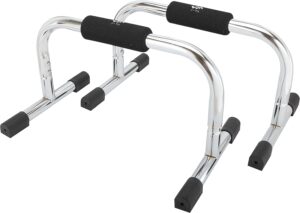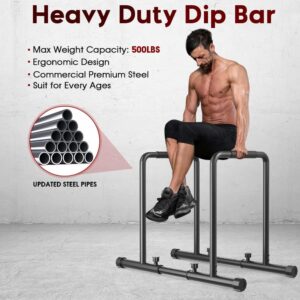If you’ve ever wanted to create your own calisthenics workout routine but weren’t sure where to start, look no further! This article will guide you through 5 simple steps to help you design an effective and personalized workout plan. Whether you’re a beginner or more advanced, these steps will provide you with the foundation you need to create a routine that fits your goals and abilities. Say goodbye to generic workout plans and hello to a routine that is tailored specifically for you. So grab a notebook and pen, because you’re about to embark on a fitness journey that is as unique as you are.

This image is property of i.ytimg.com.
Step 1: Assess Your Fitness Level
Evaluate Your Current Strength and Endurance
Before embarking on any fitness journey, it is important to assess your current fitness level. This will help you determine where you stand and what areas you need to focus on. When it comes to calisthenics, evaluating your strength and endurance is crucial.
Strength evaluation can be done by measuring how much weight you can lift for various exercises such as push-ups, pull-ups, squats, and lunges. Take note of the number of repetitions you can comfortably perform for each exercise.
Endurance evaluation involves measuring how long you can sustain physical activity without feeling exhausted. This is especially important for cardiovascular exercises like running, skipping, or cycling. Assess your ability to perform these activities for a certain amount of time without feeling completely winded.
Identify Your Goals
Once you have evaluated your strength and endurance, it is time to identify your goals. What do you want to achieve with your calisthenics routine? Do you want to build muscle, increase your overall fitness level, lose weight, or improve your flexibility?
Knowing your goals will help you tailor your workout routine to meet your specific needs. For example, if your goal is to build muscle, you might focus more on strength training exercises. If your goal is to lose weight, you might incorporate more cardiovascular exercises into your routine.
By clearly defining your goals, you can set realistic expectations and create a workout routine that will lead you towards achieving those goals.

This image is property of themovementathlete.com.
Step 2: Choose the Right Exercises
Understand Basic Calisthenics Exercises
Calisthenics exercises are exercises that use your body weight as resistance, requiring no equipment or minimal equipment. Understanding the basics of calisthenics exercises is essential in order to choose the right exercises for your workout routine.
Some common calisthenics exercises include push-ups, pull-ups, squats, lunges, planks, and burpees. These exercises target various muscle groups and can be modified to suit different fitness levels.
Select Exercises for Each Muscle Group
In order to have a well-rounded workout routine, it is important to select exercises that target each major muscle group in your body. This will help you achieve a balanced physique and prevent muscular imbalances.
Some examples of exercises for different muscle groups include:
- Chest: push-ups, chest dips
- Back: pull-ups, inverted rows
- Legs: squats, lunges, glute bridges
- Core: planks, sit-ups, Russian twists
- Shoulders: handstand push-ups, overhead pressing movements
By including exercises that target each muscle group, you will ensure that no muscle is left behind and that you achieve overall strength and muscular development.
Consider Your Equipment Options
Calisthenics exercises can be performed with little to no equipment, making them accessible to everyone. However, depending on your preferences and goals, you may choose to incorporate certain equipment into your routine.
Some common equipment options for calisthenics include resistance bands, pull-up bars, dip bars, and gymnastic rings. These tools can add variety to your workouts and provide additional resistance as you progress.
Consider what equipment options are available to you and choose those that align with your goals and preferences. Remember, you can always start with minimal equipment and gradually incorporate more as you advance in your calisthenics journey.

This image is property of cdn.shopify.com.
Step 3: Determine the Frequency and Duration
Decide How Many Days a Week You Will Work Out
When creating a calisthenics workout routine, it is important to determine how many days a week you will commit to working out. This will depend on various factors such as your fitness level, schedule, and recovery time.
For beginners, it is recommended to start with 2-3 workout sessions per week to allow your body to adapt and recover. As you become more experienced and your fitness level improves, you can gradually increase the number of workout days.
Remember, consistency is key. It is better to have fewer workout days but be consistent with them, rather than committing to too many days and burning out or skipping workouts.
Set the Duration for Each Workout Session
In addition to determining the number of workout days, you should also set the duration for each workout session. This will depend on your goals, fitness level, and availability of time.
A typical calisthenics workout session can last anywhere from 30 minutes to an hour. This includes warm-up, main exercises, and cool-down/stretching. If you have limited time, you can prioritize the most important exercises and shorten the workout accordingly.
Remember to listen to your body and give yourself enough time for proper recovery. Overtraining can lead to injury and hinder your progress, so finding the right balance between frequency and duration is crucial.

This image is property of www.barbrothersgroningen.com.
Step 4: Design Your Workout Routine
Warm-up and Stretching
Before delving into your main workout, it is important to warm up your muscles and increase your heart rate. This helps prepare your body for the upcoming physical activity and reduces the risk of injuries.
A typical warm-up routine can include exercises such as jogging or jumping jacks to increase your heart rate, followed by dynamic stretches to mobilize your joints and warm up your muscles. Examples of dynamic stretches include arm circles, leg swings, and hip rotations.
After your workout, it is also important to incorporate static stretches to improve flexibility and aid in muscle recovery. Hold each stretch for about 20-30 seconds, focusing on the major muscle groups you targeted during your workout.
Plan for Strength Training and Progression
Strength training is a crucial component of any calisthenics workout routine. It helps build lean muscle, increase strength, and improve overall body composition. To effectively incorporate strength training into your routine, you need to plan your exercises and focus on progression.
Start with exercises that challenge your current strength level but are still manageable. Gradually increase the difficulty by adding variations, increasing repetitions, or decreasing rest periods.
Aim to work each major muscle group at least twice a week, allowing for enough rest and recovery in between sessions. This will ensure optimal muscle growth and prevent overtraining.
Incorporate Cardiovascular Exercises
In addition to strength training, cardiovascular exercises are important for improving your overall fitness level and burning calories. These exercises increase your heart rate and improve cardiovascular health.
Include activities such as running, skipping, cycling, or high-intensity interval training (HIIT) in your calisthenics workout routine. Start with a duration and intensity that matches your fitness level and gradually increase as your cardiovascular endurance improves.
Remember to vary your cardiovascular exercises to keep your workouts interesting and prevent boredom. You can alternate between different activities or try new exercises to challenge yourself.
Include Rest and Recovery Days
Rest and recovery are essential components of any workout routine. They allow your muscles to repair and grow, preventing fatigue and injury. It is important to listen to your body and give it enough time to recover between workout sessions.
Incorporate rest days into your routine to allow for muscle recovery and rejuvenation. On these days, focus on activities that promote relaxation and mobility, such as gentle stretching, yoga, or low-intensity activities like walking.
Avoid the temptation to overtrain or push yourself too hard. Remember, progress happens during rest and recovery, so allow yourself adequate time to recharge and come back stronger for your next workout.

This image is property of dailyburn.com.
Step 5: Track Your Progress and Make Adjustments
Keep a Workout Journal
Tracking your progress is a crucial part of any workout routine. It helps you stay motivated, identify areas of improvement, and celebrate your achievements. Keeping a workout journal is an effective way to monitor your performance and track your progress over time.
In your workout journal, record details such as the exercises you performed, the number of repetitions or sets, and the weights or variations used. You can also note how you felt during the workout and any observations or challenges you encountered.
Reviewing your workout journal allows you to see how far you have come and make adjustments to your routine as needed. It also provides valuable insights into what works best for your body and helps you set realistic goals for the future.
Monitor Your Performance and Results
Aside from tracking your progress in a journal, it is important to regularly monitor your performance and assess your results. This can be done through periodic fitness assessments or by monitoring key indicators such as strength, endurance, body composition, and overall fitness level.
You can perform simple tests such as measuring the number of repetitions you can do for a specific exercise or timing yourself for a certain distance for cardiovascular activities. Regularly reassessing your fitness level helps you stay accountable to your goals and make necessary adjustments to your routine.
Modify Your Routine as Needed
As you progress in your calisthenics journey, it is important to periodically re-evaluate and modify your workout routine. As your strength and endurance improve, you will need to increase the intensity, difficulty, or complexity of your exercises to continue challenging your body and promoting progress.
Incorporate new exercises, explore different variations, or increase the weight or repetitions for resistance exercises. Continuously challenging your body and introducing new stimuli prevents plateaus and keeps your workouts exciting.
Remember, your calisthenics workout routine should evolve as you do. Stay open to experimentation and listen to your body’s feedback to ensure that you are getting the most out of your workouts.
Creating your own calisthenics workout routine takes time and experimentation. By following these steps, you will be able to assess your fitness level, choose the right exercises, determine the frequency and duration, design your routine, track your progress, and make necessary adjustments. With consistency and determination, you will be well on your way to achieving your fitness goals through calisthenics. Start your journey today and enjoy the countless benefits of this versatile and rewarding form of exercise!





